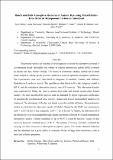Files in this item
Batch and bulk adsorptive removal of anionic dye using metal/halide-free ordered mesoporous carbon as adsorbent
Item metadata
| dc.contributor.author | Mittal, Jyoti | |
| dc.contributor.author | Mariyam, Asna | |
| dc.contributor.author | Sakina, Farzeen | |
| dc.contributor.author | Baker, Richard T. | |
| dc.contributor.author | Sharma, Ashok K. | |
| dc.contributor.author | Mittal, Alok | |
| dc.date.accessioned | 2022-09-14T23:40:29Z | |
| dc.date.available | 2022-09-14T23:40:29Z | |
| dc.date.issued | 2021-10-25 | |
| dc.identifier | 275967537 | |
| dc.identifier | aa8fa9a9-efd4-4ad3-a12a-c62cf0d96181 | |
| dc.identifier | 85115032378 | |
| dc.identifier | 000705777200104 | |
| dc.identifier.citation | Mittal , J , Mariyam , A , Sakina , F , Baker , R T , Sharma , A K & Mittal , A 2021 , ' Batch and bulk adsorptive removal of anionic dye using metal/halide-free ordered mesoporous carbon as adsorbent ' , Journal of Cleaner Production , vol. 321 , 129060 . https://doi.org/10.1016/j.jclepro.2021.129060 | en |
| dc.identifier.issn | 0959-6526 | |
| dc.identifier.other | RIS: urn:E09B0CA0204EE73B3C32140EDDD97C4A | |
| dc.identifier.other | ORCID: /0000-0002-3304-3280/work/100549636 | |
| dc.identifier.uri | https://hdl.handle.net/10023/26019 | |
| dc.description | The authors are grateful to the Ministry of Human Resource Development of the Government of India for financial support through the SPARC Project- SPARC/2018–2019/P307/SL. One of the authors (Asna Mariyam) is also grateful to MANIT, Bhopal for providing fellowship assistance. We thank the University of St Andrews for a PhD scholarship for FS. We acknowledge EPSRC Strategic Resources Grant (EP/R023751/1). | en |
| dc.description.abstract | The present report is an outcome of investigations to assess the adsorptive potential of a synthesized metal- and halide-free variant of ordered mesoporous carbon (OMC) towards an anionic azo dye, Methyl Orange. The results of preliminary studies, carried out in batch mode, helped in setting up the process variables to achieve optimum adsorption conditions. The experimental data were then fitted to Langmuir, Freundlich, Temkin, and Dubinin-Radushkevitch isotherm models. The equilibrium data fitted well to the Langmuir model at 303 K and the monolayer adsorption capacity was 0.33 mmol g−1. The adsorption kinetics were explored by fitting the data to pseudo-first-order and pseudo-second-order kinetic models. The latter described the kinetics well, as indicated by higher regression coefficients. To elucidate the mechanism of mass transfer, various well-known mathematical models were employed. The adsorption of the dye was found to involve particle diffusion. Thermodynamic studies revealed that the adsorptive uptake of Methyl Orange by the OMC was spontaneous (ΔG0 = −23.71 kJ mol−1) and exergonic (ΔH0 = −123.15 kJ mol−1). Finally, the bulk removal of the anionic dye was investigated through column operations followed by column regeneration (desorption) studies. Column saturation of up to 96.55% could be realized. Values for dye recovery reached up to 93.26%. The column efficiency was then evaluated by carrying out three consecutive adsorption/desorption cycles. The results obtained indicated that the adsorbent has a good ability to eliminate Methyl Orange from wastewater, both in batch and column operations. | |
| dc.format.extent | 14 | |
| dc.format.extent | 1902450 | |
| dc.language.iso | eng | |
| dc.relation.ispartof | Journal of Cleaner Production | en |
| dc.subject | Methyl orange | en |
| dc.subject | Adsorption | en |
| dc.subject | Isotherms | en |
| dc.subject | Kinetics | en |
| dc.subject | Particle-diffusion | en |
| dc.subject | Bulk | en |
| dc.subject | Removal | en |
| dc.subject | Wastewater treatment | en |
| dc.subject | QD Chemistry | en |
| dc.subject | NDAS | en |
| dc.subject | AC | en |
| dc.subject.lcc | QD | en |
| dc.title | Batch and bulk adsorptive removal of anionic dye using metal/halide-free ordered mesoporous carbon as adsorbent | en |
| dc.type | Journal article | en |
| dc.contributor.sponsor | EPSRC | en |
| dc.contributor.institution | University of St Andrews. School of Chemistry | en |
| dc.contributor.institution | University of St Andrews. Centre for Energy Ethics | en |
| dc.contributor.institution | University of St Andrews. EaSTCHEM | en |
| dc.identifier.doi | 10.1016/j.jclepro.2021.129060 | |
| dc.description.status | Peer reviewed | en |
| dc.date.embargoedUntil | 2022-09-15 | |
| dc.identifier.grantnumber | EP/R023751/1 | en |
This item appears in the following Collection(s)
Items in the St Andrews Research Repository are protected by copyright, with all rights reserved, unless otherwise indicated.

